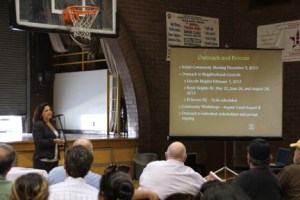By Amy E. Hamaker
Big changes are coming to the Health Sciences Campus neighborhood as part of the USC HSC Master Plan. As part of the community, USC recently invited neighborhood residents to add their input to the process.
Two special workshops on implementation of the HSC Master Plan and streetscape were held for community members on Aug. 3 and Aug. 8 at Hazard Park. The events were co-sponsored by the LA-32 Neighborhood Council and the office of Councilmember José Huizar.
Approved by university trustees in 2011, the Master Plan guides future campus growth for academic, research and clinical space over the next 25 to 30 years. Boundaries include Valley Blvd. (north), Soto St. (east), Zonal Ave. (south) and Mission Rd. (west).
“I believe that democracy is at its best when people come together, and I really do appreciate the fact that you are here,” said Martha Escutia, vice president, government relations for USC, who welcomed the crowd. “USC is your neighbor, and has been here for more than 100 years. USC is going to stay here for as long as possible because they have made a commitment to this community.”

Laurie Stone, executive director of land use & planning, presents details of USC’s community outreach and the components of the Master Plan to community members at a workshop at Hazard Park on Aug. 3.
(Photo/Amy E. Hamaker)
Laurie Stone, executive director of land use & planning, gave a short presentation on plan implementation as part of a formal outreach process. The presentation included:
- New student housing: A four-story, 157-unit housing facility for graduate medical students and their families. Developer American Campus Community is building and operating the housing for the university, and the facility is anticipated to open in fall 2016. The building will be located north of Alcazar St., between Soto and San Pablo Streets, and will include an additional day care center for the campus, more than doubling current existing capacity.
- Hotel: A 200-room building with extended-stay suites for families visiting patients at the Keck Medical Center of USC and for the community. Plans include retail space on the ground floor, a restaurant and 14,000 square feet of conference space. Although the university is still in negotiation with developers, opening is anticipated in 2016 and the hotel will be located at the northeast corner of San Pablo and Alcazar Streets.
- Norris Healthcare Consultation Center: A 110,000-square-foot facility to house cancer-focused medical activities, including multidisciplinary clinics designed to facilitate interaction among teams, infusion therapy, an ambulatory surgery center and a women’s cancer program. Ground was broken on the project on May 2; the building will be located on Alcazar St. behind Keck Hospital of USC.
- Norfolk Street Extension and Streetscape Beautification: The City’s General Plan includes the completion of Norfolk St., from Playground St., to connect it with Soto St. To accomplish this, current handball courts will be moved to a new location and a new traffic signal will be added at the intersection of Norfolk and Soto Streets. Several benefits to the park itself have also been proposed, including a new play structure for children ages 2-5, upgrades to gym restrooms, a new ADA-compliant path from the handball courts to the gym, new lighting, new trees, and new picnic tables and benches for the new handball courts.
In addition to the extension, the university is investing significantly in the overall campus streetscape, with the underground placement of overhead utilities, sidewalk widening, more than 200 new street trees, new street lighting, decorative brick banding in sidewalks and crosswalks, and a comprehensive signage program.
Community comments centered on the Norfolk Street Extension, and the concern that current green space will be lost and traffic, noise and pollution will all increase. Speakers also suggested that USC work with the community to better determine needs for Hazard Park. After the open comment session, consultants and experts were available to answer individual questions from the public.
Craig Keys, associate senior vice president, civic engagement, thanked audience members for their comments and suggestions. “We need your comments and ideas to make this project work for both the university and the community,” he said.

